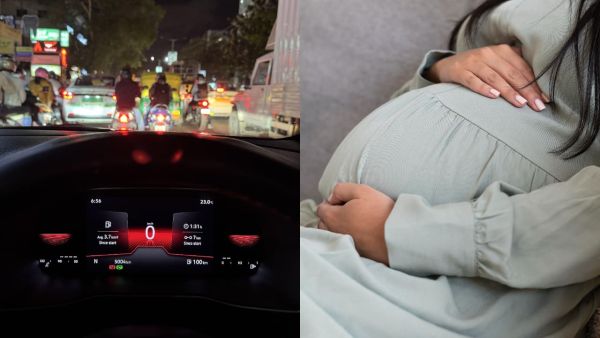
Bengaluru’s traffic crisis has reached alarming levels, leaving residents frustrated and questioning the city’s livability. Commuters now routinely face severe congestion, pothole-ridden roads, and unpredictable jams that turn even short journeys into hours-long ordeals. The city’s infrastructure appears unable to cope with the growing population and skyrocketing vehicle numbers, raising concerns about safety during emergencies. Despite paying hefty road taxes, residents often feel helpless when traffic snarls prevent timely access to hospitals, workplaces, or essential services.

A Bengaluru resident recently shared his terrifying experience on Reddit. He recounted taking his eight-month pregnant wife for a routine check-up along HAL Road near Varthur. What should have been a 7 km journey turned into a gruelling 1.5-hour ordeal.
“What if this was a real emergency? What if she went into labour right now?” he wrote, describing the suffocating helplessness of being trapped in slow-moving traffic while precious minutes slipped away. He warned that such delays are not merely inconvenient, they could be potentially life-threatening during real emergencies.
The commuter shared that his journey, which should have taken a few minutes, stretched to an excruciating 90 minutes. “The sheer helplessness is suffocating. You’re just a sitting duck, trapped in a metal box, watching the clock tick by,” he said. He emphasised that such situations could be catastrophic during real emergencies, where every minute counts.
One user commented: “Bro I think you should temporarily shift to a nearby hospital cause this could have been an emergency.”
The resident replied: “This is the nearest maternity hospital near my home. I’ve seen ambulances struggling to get out in a timely manner numerous times in Bengaluru.”
Third user commented: “Bro move out of Bengaluru if possible for next 1 month till you have your baby at least. This city is truly not livable any more. I seriously sometimes pity the people living in the IT corridor, especially. What a dystopian world they are living in.”
Fourth user commented: “IMO, post-Covid traffic is insane. Earlier, I knew to avoid routes like Silk Board at peak hours. Nowadays, you don’t know which route is going to choke and at what time. Always making sure petrol tank is full. Happened with me yesterday.”
Another user commented: “I left the office at 6:00 PM in a cab. Around 6:30, my wife called me and told me she wasn’t feeling well. Sitting helpless in traffic, unable to do anything, each minute felt like a year. I called my friends. Fortunately, they took her to a doctor nearby. It took me another two and a half hours to finally reach home and ensure she was okay. That 3-hour long ride through traffic made me realise how helpless it feels when someone at home needs you, and you just can’t get there in time just because of the traffic.”
One user commented: “I can understand! My mum and sis met with an accident and I had to rush to visit them in the hospital. I was stuck in that U-turn near Bellandur. Longest 45 minutes of my life. Regretted going to Bellandur office that day! There is a way out, but it will require all of us to get on the roads instead of cribbing on social media every day.”
Another user commented: “Bengaluru traffic is getting terrible day by day. Even for a usual 15–20 minute ride, you will have to get stuck in traffic for hours. Even my wife is pregnant and the hospital I chose for her is situated at a mere 6 km distance from my home, but it takes me around 1 hour to reach there. On top of that, the road is filled with potholes, some so deep that if you don’t see them on time, you get bumped hard—even though I drive an XUV which has more ground clearance than other vehicles.”
These experiences underscore the growing question of Bengaluru’s livability. Daily commuters and residents face long delays, poor road conditions, and unpredictable traffic jams that can turn routine errands or medical visits into traumatic ordeals. Stories like these reveal a city grappling with infrastructure collapse, population pressure, and urban planning challenges, raising urgent questions about the quality of life in India’s IT capital.